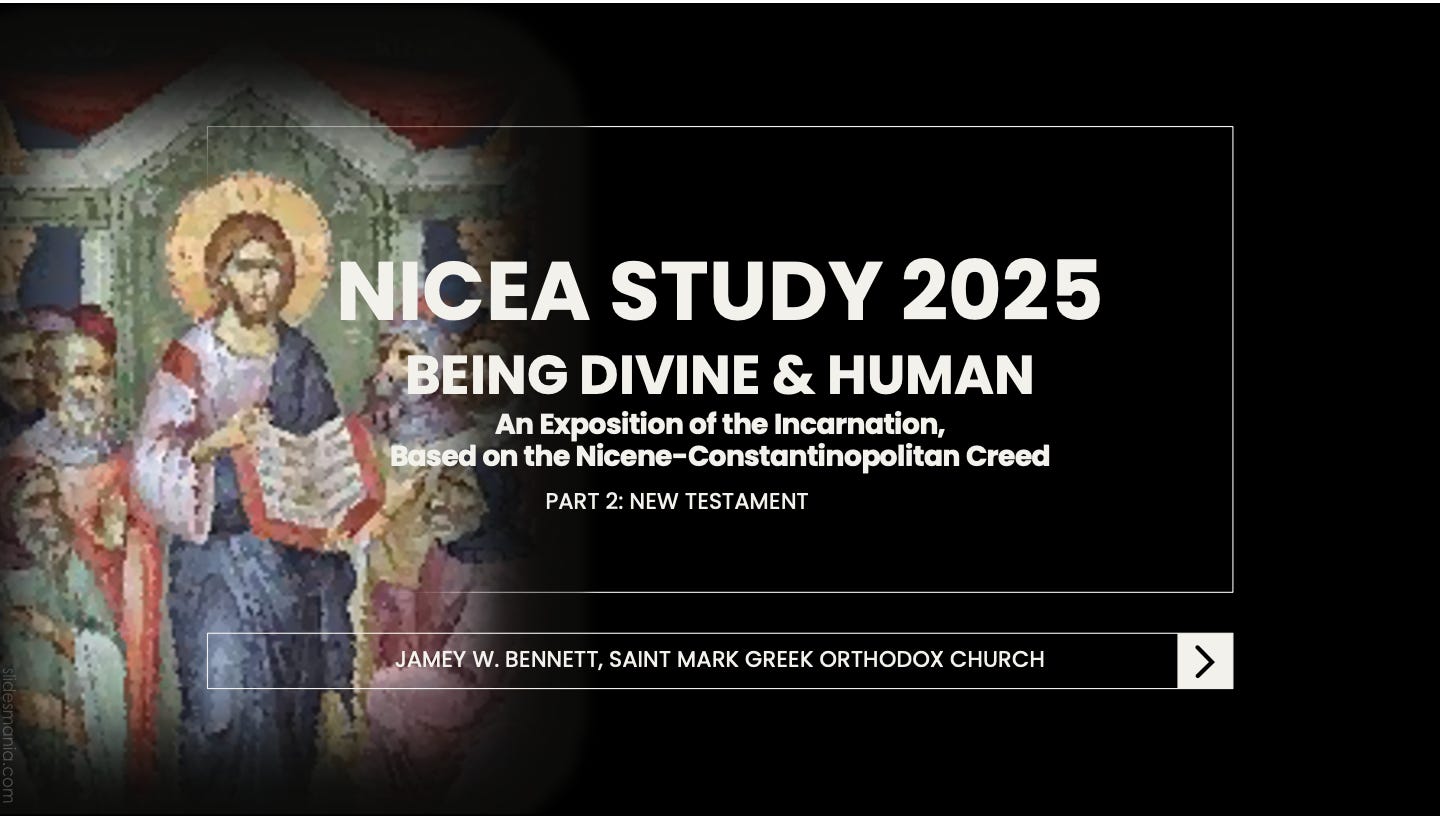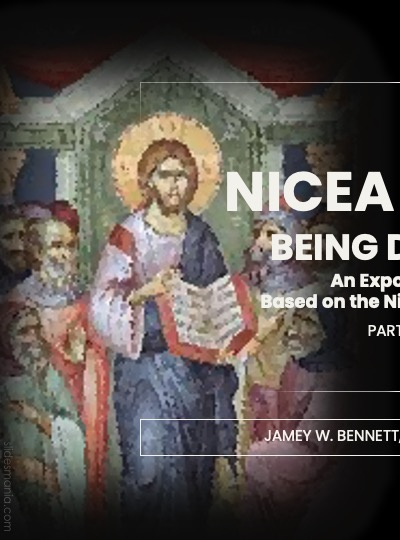Being Divine and Human: Jesus Christ in the New Testament
Part 2: The New Testament—An Exposition of the Incarnation, Based on the Nicene-Constantinopolitan Creed
The following is based on a class presentation at Saint Mark Greek Orthodox Church in Boca Raton, Florida. The article has been adapted from an in-person class—the video is included below, along with a PDF download of the slideshow. This is the fourth part of a five part series on the Creed, you can also view the first, second, or third article in the series. We are sharing the material in the order it was presented locally at our parish.
Introduction: Sacrifice and Life
There was once a Catholic nun of Seneca Iroquois heritage whose mother taught her a personal ritual called the "sacrifice flower." When she felt overwhelmed by a burden, she would go out and find a special flower, bring it home, and entrust it with her prayer—the specific sorrow she wished to give to God. This practice (while certainly not a normative sacramental act) became a deeply personal way for her to visualize the act of surrender and offering.
The ritual was rooted in the flower giving its life. As it slowly wilted, she acted as if the life force carried her prayer up to the heavens. “Every time I saw the flower,” she wrote, “I could see it giving its life for me and could imagine my prayer being carried to the Lord.” When the flower finally died, she would bury it, thanking it for its service and hoping it might find new life in the earth.
I share this story because it provides a tangible image for a concept that can often feel abstract. This simple ritual illustrates that new life and communion with God comes through a life-giving, sacrificial offering. Christ's death on the cross is at the heart of our faith, as encapsulated in the Nicene Creed, and includes sacrifice at the heart of the meaning of Christ’s work in this world.
The Creed provides a foundational understanding of how we see and know Jesus Christ: in His sacrifice, incarnation, crucifixion, resurrection, ascension, and promised return. Today we will consider these mysteries in light of the testimony of the Nicene Creed.
The Foundation of Sacrifice
In our modern world, the concept of sacrifice can feel distant, yet it is essential for understanding Christ's death on the cross. Archbishop Dimitri of blessed memory taught that everything Christ did was for “the restoration of fallen mankind and the reconciliation of the world to Himself.” This work finds its roots in the Jewish tradition of sacrifice, which was central to worship during both the First Temple (10th and 6th centuries BC) and the Second Temple period (6th century BC to 1st century AD).
Under the Old Covenant, sacrifices served distinct purposes:
The whole burnt offering was an act of complete dedication to God,
the peace offering expressed gratitude,
and the sin offering sought atonement for wrongdoing.
The Jewish philosopher Philo of Alexandria noted that the burnt offering honored God alone, while the peace and sin offerings addressed human needs. The key to these rituals was blood, which symbolized and carried life. As Leviticus 17:11 states, “For the life of the flesh is in the blood, and I have given it to you upon the altar to make atonement for your souls.”
Christ's sacrifice fulfills and transcends these ancient offerings. The New Testament reveals Him as the “Lamb of God, who takes away the sin of the world” (John 1:29). He is the perfect Paschal Lamb whose death reconciles humanity to God. As Romans 5:10 affirms, “We were reconciled to God through the death of His Son.”
His was the ultimate self-offering; as St. Gregory the Theologian wrote in his Mystical Hymn to the Son:
“He was the victim, but at the same time, the High Priest, the Sacrificer, but also God: He offered blood to God, but he purified the world; he was lifted up on the cross, but he nailed sin to the cross.”
Christ is both priest and victim, whose sacrifice purifies the world and nails sin to the cross.
As mentioned, this article is a summary of a larger class presentation. Download a PDF of the slideshow and watch the hour long teaching video below:
The Incarnation: God Becomes Man
The Nicene Creed proclaims that Christ “was incarnate of the Holy Spirit and the Virgin Mary, and became man.” This doctrine, the Incarnation, is the linchpin of our faith—the profound mystery of God taking on human flesh. “No one has ascended to heaven but He who came down from heaven, that is, the Son of Man,” Jesus explains in John 3:13. The incarnation is an act of divine love, making the unknowable God known to us, drawing us from darkness into His uncreated light (1 Peter 2:9).
The Virgin Birth, re-affirmed at the Third Ecumenical Council in AD 431, protects the truth that Christ was born of God, not of human will. The Orthodox tradition holds that Mary, the Theotokos (God-bearer), remained ever-virgin, a belief rooted in the early Church’s understanding of her as a living, breathing Holy of Holies. The Holy Fathers of the Church often applies the prophecy in Ezekiel 44:2 to her: “This gate shall be shut; it shall not be opened, and no man shall enter by it, because the Lord God of Israel has entered by it.” In her, we glimpse the sacred doorway through which God Himself stepped into our world, forever changing the story of the world.
SIDEBAR ON THE PERPETUAL VIRGINITY OF MARY:
When the New Testament mentions Jesus’ “brothers” (Mark 6:3), the early Church (including figures like St. John Chrysostom), interpreted these as cousins or stepbrothers from Joseph’s previous marriage (he was a widower).
This understanding makes sense of Jesus’s actions at the cross, where He entrusts His mother to the Apostle John, saying, “Woman, behold your son,” and to John, “Behold your mother” (John 19:26-27).
If Jesus had younger siblings (as many Protestants suggest), this act of Christ’s doesn’t make much sense. It makes the most sense of all the data to simply trust the early Church’s testimony that Mary had no other sons to care for her, supporting the belief in her perpetual virginity.
The Nature of Christ: Fully God and Fully Man
The Creed’s statement that Christ “became man” introduces the doctrine of the hypostatic union—the perfect joining of divine and human natures in the single person of Jesus Christ. The Council of Chalcedon (AD 451) defined this union as existing “without confusion, without change, without division, without separation.” St. John Chrysostom explains it this way: “By a union and conjunction, God the Word and the flesh are a unity; there is no confusion or annihilation of substances.” Christ is fully God, and therefore is unchanging in His divine being (Malachi 3:6 reads: “For I the LORD do not change…”)—yet fully human, embracing our nature in order to conquer death and to raise us to everlasting life.
This dual nature is powerfully displayed in the Garden of Gethsemane. As He faces His impending suffering, Jesus prays, “Father, if it is Your will, take this cup away from Me; nevertheless not My will, but Yours, be done” (Luke 22:42). Here, we see His human will wrestling with suffering, yet ultimately submitting in perfect harmony to His divine will and purpose.
The Crucifixion and Resurrection: Victory Over Death
The Creed continues, “He was crucified for us under Pontius Pilate, and suffered, and was buried.” This statement anchors Christ’s sacrifice within history, confirming it was not a myth but a real event. He truly and actually died bodily.
Christ’s death confronts the universal human condition described in Romans 5:12: “Through one man sin entered the world, and death through sin.” Through His sacrifice, we find liberation.
Ephesians 1:7 proclaims, “In Him we have redemption through His blood, the forgiveness of sins, according to the riches of His grace.”
By becoming a curse for us (Galatians 3:13), Christ shatters the power of death itself, as explained in Hebrews 2:14-15, releasing "those who through fear of death were all their lifetime subject to bondage."
Christ’s suffering was real. Even on the cross, His love remained scandalous and boundles—as He forgave His executioners (Luke 23:34) and promised paradise to the repentant thief (Luke 23:43). His burial confirms His true death, and His resurrection on the third day fulfills the Scriptures (1 Corinthians 15:4). As the “firstfruits of those who have fallen asleep” (1 Corinthians 15:20), Christ’s resurrection transforms death from an end into a doorway to eternal life.
The Ascension and Second Coming: An Eternal Kingdom
Forty days after His resurrection, Christ “ascended into heaven and sits at the right hand of the Father.” His ascension in His glorified human body assures us that our own humanity is exalted with Him—it is a promise of our own future resurrection and union with God. Christ’s position at God’s right hand signifies that His kingdom has begun, fulfilling the promise to David that “He will reign over the house of Jacob forever, and of His kingdom there will be no end” (Luke 1:32-33).
The Creed echoes this text, concluding this section with the promise that “He shall come again with glory to judge the living and the dead, whose kingdom shall have no end.” His return will usher in the final judgment and the resurrection of all. “We must all appear before the judgment seat of Christ,” the Apostle Paul writes, “that each one may receive the things done in the body, according to what he has done, whether good or evil” (2 Corinthians 5:10). This final judgment is not merely a verdict, but the beginning of the eternal state, where the last enemy—death itself—is finally destroyed (1 Corinthians 15:26).
Living in the Light of Christ's Work
The Nicene Creed is more than a statement of belief; it is an invitation to align our lives with Christ, the King and Savior who has accomplished everything for our salvation. From His incarnation to His eternal reign, every act is a revelation of God’s love for mankind and restorative purpose for the cosmos.
We are called to respond to this outpouring of love by living sacrificially, offering our own lives in service to others—a service that Christ Himself tells us He receives as service to Him (Matthew 25:35-40). By embracing His sacrifice, we share in His victory over sin and death, and we wait with hope for the day His kingdom is fully revealed.
Select Bibliography
Behr, John. Becoming Human: Meditations on Christian Anthropology in Word and Image. Crestwood, NY: St Vladimir’s Seminary Press, 2013.
Bucur, Bogdan G. Scripture Re-envisioned: Christophanic Exegesis and the Making of a Christian Bible. Leiden/Boston: Brill, 2019.
Bishop Danilo (Krstic) Hieromonk Amfilohije (Radovic). No Faith is More Beautiful than the Christian Faith. Los Angeles: Sebastian Press, 2015.
Pentiuc, Eugen J. Hearing the Scriptures: Liturgical Exegesis of the Old Testament in Byzantine Orthodox Hymnography. New York: Oxford University Press, 2021.
Pentiuc, Eugen J. Jesus the Messiah in the Hebrew Bible. Mahwah, NJ: Paulist Press, 2006.
Bishop Dmitri (Royster) of Dallas. The Doctrine of Christ: A Layman’s Handbook. Miami: Diocesan Publications, 1984.
Download PDF (above) for more detailed source references.
Prefer to watch the video on YouTube? Here you go!




